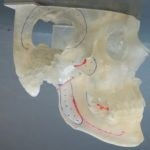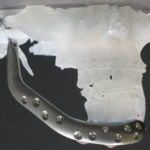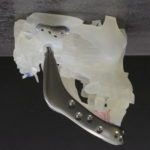Temporo-Mandibular Joint (TMJ) Deformities
Fractures of Upper and Lower Jaw
Ankylosis of the temporromandibular joint (TMJ) is a disabling condition that causes problems in mastication, digestion, speech, function, cosmesis, and maintenance of oral hygiene. It can also cause disturbance of facial growth and acute compromise of the airway, which invariably results in physical and psychological disablity. TMJ ankyloses us usually results from injury (13-100%), local or systemic infection (10-40%), or systemic disease (10%), such as ankyloses spondylitis, rheumatoid arthritis, and psoriasis. It may also result from surgery to the TMJ. The hypothesis propsed for trauma cases is that intra-articular haematoma, scarring, and the formation of excessive bone gives rise to hypomobility. Specific consequences from falling might include the limitation of jaw movement that restricts you to open your mouth, chew or speak perfectly, thus, impeding communication and feeding which are vital for survival and socialization.
The treatment of TMJ ankyloses to restore full mouth opening and normal oral function remains a significant challenge to clinicians and patients (children and adults) due to technical difficultyies and a high incidence of recurrences.
Various procedures for the treatment of TMJ ankyloses have been described in the literature. These include gap arthroplasty, interpositional gap arthroplasty, and/or joint reconstruction using autogenous grafts or alloplastic materials may experience infection and inflammatory problems as the immune system reacts to a foreign body. Autogenous interpositional materials, such as temporails muscle, dermis-fat grafts, and auricular cartilage, have been used in several studies to prevent re-ankylosis. Some authors have suggested using the remaining TMJ disc, after its repositioning. Several autologous bone grafts are used to reconstruct the ramus-joint complex, including costochondral grafts (CCG) and clavicular bone grafts. The resected elongated coronoid process, excited ankylotic mass and sliding ramus osteotomy have also been tried. Distraction osteogenesis has been used successfully before and after the release of the joint ankylosis, to correct secondary facial asymmetry. To avoid relapses, wide bone resection of ankylosis remains the most important aspect of the surgical protocol, regardless of the technique used.
Right
Left


Patients with end-stage TMJ pathology resulting in anatomical architectural form distortion and physiological dysfunction dictates the need for total alloplastic joint replacement (TJR). These conditions include 1) multiply operated TMJs 2) 2 previous surgeries): 2) failed autogenous grafts; 3) failed TMJ alloplastic implants, including Proplast-Teflon (PT; Vitek, Inc, Houston, TX) and silicone elastomers (Dow-Corning, Midland, MO); 4) high or low inflammatory metabolic arthritic diseases; 5) connective tissue or autoimmune diseases(ie, rheumatoid arthritis, juvenile idiopathic arthritis, scleroderma, Sjogren syndrome, lupus, etc); 6) fibrous or bony ankyloses; 7) absent or deformed anatomic structures resulting in loss of posterior mandibular vertical dimension (ie, fractured displaced condyles, abscense of condyles and portions of the ramus as the result of previous trauma, surgery, pathology, or congenital deformity); 8) tumors involving the TMJ and the adjacent mandible; and 9)other end-stage TMJ pathologies. However, some of these aforementioned TMJ conditions can have an adverse effect on the viability of autogenous tissue grafts, resulting in a high incidence of graft failure.
The essential life functions of mastication, speech, airway support and deglutition are supported by proper TMJ function and form. This puts the TMJ complex under more cyclical loading and unloading than any other body joint over a lifetime. Therefore, to provide long-term effective outcomes, the TMJ TJR device chosen must be capable of managing the anatomical, functional and aesthetic discrepancies that influenced its choice. The goal of TMJ TJR is the restoration of mandibular function and form. The recent improvements in technology, alloplastic TMJ TJR reconstruction device is gaining popularity, with potential advantages including mimicking the normal anatomy and restoring vertical dimension, avoidance of donor site morbidity, reduction in operating time, reduction in joint pain, a reduce risk of recurrent ankyloses, improved aesthetic results, and immediate physiotherapy can be given. However, alloplastic TMJ reconstructive materials are typically not useful in growing patients. The major advantages of alloplastic over autogenous TMJ TJR reconstruction are that a second surgical site (with its potential increased morbidity) is not needed and that the expensive intraoperative and postoperative hospital time is greatly reduced.
Right


Left
A patient custom-fitted total joint prosthesis can provide accurate adaptation of a TMJ TJR device anatomic structures for each patient. Most recent studies by Henry and Wolford, Mercuri and Giobbe-Hurder that TMJ Concepts custom-fitted CAD and CAM TMJ devices had an 86% success rate relative to jaw and occlusal stability, improved JawFn(function) and decrease in pain. Although the life expentancy of TMJ Concepts devices is still unknown, based on the CAD and CAM plan, the biomaterials involved in the manufacture, patient specificity, the lower functional loading forces applied to the TMJ complex compared with the knee and hip, and the relative ease and speed of implantation, these devices should have a lifespan longer than their orthopedic joint counterparts
Right


Left
The TMJ Concepts are computer-assisted designed (CAD) and computer-assisted manufactured (CAM) devices that fit the specific anatomic, functional, and esthetic requirement of each patient. The material used to create the patient’s fossa is made up of wrought Titanium alloy while the head or condyle is compose of cobalt-chromium-molybdenum alloy. The articulating surface of the fossa is made with ultrahigh-molecular-weight polyethylene (UHMWPE). Each of the component is manufactured with biologically compatible materials that provides stability and resist wear conditions over time.

































